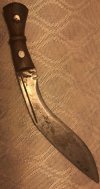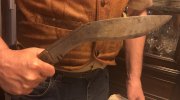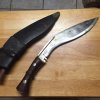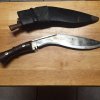- Joined
- Feb 23, 1999
- Messages
- 4,855
Kami Sherpa had 5 years of service in an Indian Gurkha regiment back in the 50s. Prior to that he spent several years in advanced study with Tibetan Buddhist lamas. This is very rigorous academic training in philosophy, meditation, and debate/oratory. His karma swept him into military service before he completed those studies though. Had it not, he might have ended up a lama and the whole history of HI and the khukuri in the west might be quite different.
I asked Kami Sherpa about the kukri he carried during his service. That khukuri disappeared, but he had a very similar one of Indian manufacture that he had been using around the house for the last couple of decades. It was of the design many of you have seen before, coming out of India. A wooden chiruwa handle with a thick, blocky central ring. Many years ago I had an inexpensive one of that design and the wood had pulled away from the tang. It would tear up my hands when chopping and I finally gave it away. Kami Sherpa’s Indian knife was well worn and comfortable in the hand though, helping me understand how serviceable that design can be.
I still prefer the Nepalese designs, and the British Gurkha regiment standards. HI craftsmanship is generally much superior, with better fit and finish and a more refined design for the central locking ring. However, the Indian design can be better crafted than those we often see. It is quite interesting that a well crafted knife of this design has seen so many years of hard service right in the heart of the HI operation.


I asked Kami Sherpa about the kukri he carried during his service. That khukuri disappeared, but he had a very similar one of Indian manufacture that he had been using around the house for the last couple of decades. It was of the design many of you have seen before, coming out of India. A wooden chiruwa handle with a thick, blocky central ring. Many years ago I had an inexpensive one of that design and the wood had pulled away from the tang. It would tear up my hands when chopping and I finally gave it away. Kami Sherpa’s Indian knife was well worn and comfortable in the hand though, helping me understand how serviceable that design can be.
I still prefer the Nepalese designs, and the British Gurkha regiment standards. HI craftsmanship is generally much superior, with better fit and finish and a more refined design for the central locking ring. However, the Indian design can be better crafted than those we often see. It is quite interesting that a well crafted knife of this design has seen so many years of hard service right in the heart of the HI operation.







